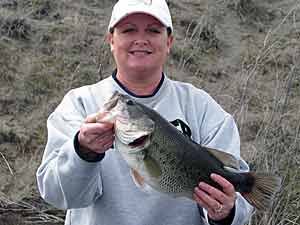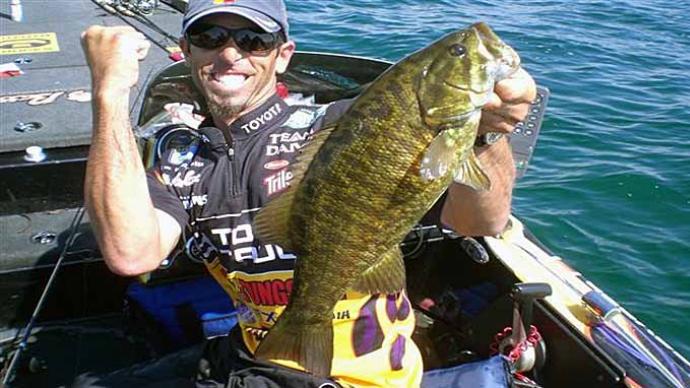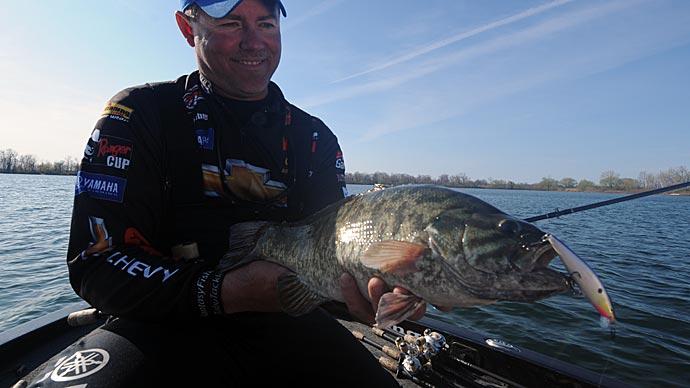
It's springtime. You know that the fishing in your next tournament will be great. You probably have at least two spinnerbaits tied on and a jig, lizard or a lipless crank laying on your front deck all ready to go. In most tournaments this month, these will usually be the predominate baits.
But what do you do, if during practice or even in your actual tournament halfway through you're looking at zero or maybe just one bass? You know you have to do something different. Do you speed up, slow down, or change locations? We've all faced these questions at one time or another in our tournament fishing. Speed up, cover as much water as possible and hope you make contact with some active fish. Slow down, you're confident the bass are there and you just try to make them bite. Bass rarely move to the other end of the lake, so you must find a happy medium between the two.
So what's a tournament angler going to do? The most overlooked technique to catch really tough springtime bass is the use of jerkbaits. Most anglers don't try jerkbaits in early spring. The common perception is that jerkbaits don't produce until late spring. This spring put the jerkbait option in your arsenal. There are three basic types of jerkbaits: soft, floating, and suspending.
When you consider the jerkbait option, there's two important factors: water temperature and clarity. Jerk-baits would be a poor choice in muddy water. In fact the clearer the water, better. Jerkbaits will work in any water temperature. The guidelines to go by as far as temperature is concerned, is that suspending and soft jerkbaits will work in water below and above 57 degrees and the floating ones will really be productive below 57 degrees. The least understood and used is the suspending model. When bass are finicky this should be your first choice. The key is to experiment with your lures. Not all will act the same under similar conditions. You have to remember that the suspending characteristics of a jerkbait changes with water temperatures. You have to customize your baits if you want them to have the correct action. With a jerkbait, you want them to totally suspend or rise just a little. The two brands that I use and have good luck with are either Lucky Craft or Strike King jerkbaits. About the only three colors I prefer are gold, shad, or clown-colored baits.
When the bass get closer to the spawn, I'll switch to a floating jerkbait. These lures will be a good choice if the area you're fishing your tournament in is getting heavy pressure. You'll need to work the floating version faster than the suspending models. You'll have to let the bass tell you how they want it. Sometimes the only way to entice a strike is to let it rest on top. When the fish want it on top, your hook-up ratio will improve if you'll hesitate before setting the hook. My favorite choice for floating jerkbaits is the Bomber Long A, in the gold flash color.
The third choice of jerkbaits is the soft jerkbait. This last method will account for more bass than the other two combined. I never head into a tournament this time of year without at least one soft jerkbait tied on. Almost always I'll use a shad-colored lure first. With a soft jerkbait you can rig it several ways. My first choice is with a 4/0 offset Gamakatsu hook, 15-pound green Big Game line. I'll put a 1/32-ounce split shot next to the head of the lure. Another trick I do is put a barrel swivel eight to 12 inches in front of the hook. If the bass are trying to spawn, one of my most productive retrieves is letting the lure go to the bottom and let it just sit there. I'll then give it three or four short quick jerks and let it go to the bottom again. Make sure that you insert the hook so that bait will dive. Never set the hook when you first see the strike. Wait until you see the line moving or actually feel the fish on the bait.
When you approach your next tournament this month, it will help you at the final weigh-in if at least one of your rods is rigged with a jerkbait. Use any rod that you'd use with a spinnerbait and it will work.
Good luck and God Bless.
Bill Wilcox is sponsored by Ranger Boats, Yamaha Outboards, MCMC, BG Products, Pro Rule, Johnson Fiberglass, Brown's Automotive, Continental Batteries, Kistler Rods, Swamp Hog Lures, Strike King Lures, and Fun-n-Sun Sports Center.




